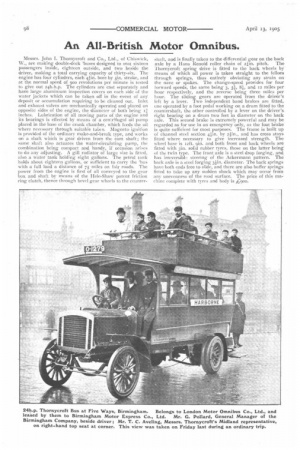An All-British Motor Omnibus.
Page 6

If you've noticed an error in this article please click here to report it so we can fix it.
Messrs. John I. Thornycroft and Co., Ltd., of Chiswick, W., are making double-deck 'buses designed to seat sixteen passengers inside, eighteen outside, and two beside the driver, making a total carrying capacity of thirty-six. The engine has four cylinders, each 4*in. bore by sin, stroke, and at the normal speed of goo revolutions per minute is tested to give out 24b.h.p. The cylinders are cast separately and have large aluminium inspection covers on each side of the water jackets which can be taken off in the event of any deposit or accumulation requiring to be cleaned out. Inlet and exhaust valves are mechanically, operated and placed on opposite sides of the engine, the diameter of both being inches. Lubrication of all moving parts of Llw engine and its bearings is effected by means of a centrifugal oil pump placed in the base of the crank chamber, which feeds the oil where necessary through suitable tubes. Magneto ignition is provided of the ordinary make-and-break type, and works on a shall which is gear driven from the cam shaft; the same shaft also actuates the water-circulating pump, the combination being compact and handy, if occasion arises to do any adjusting. A gill radiator of large size is fitted, also a water tank holding eight gallons. The petrol tank holds about eighteen gallons, or sufficient to carry the 'bus with a full load a distance of 75 miles on fair roads. The power from the engine is first of all conveyed to the gear box and shaft by means of the Hele-Shaw patent friction ring clutch, thence through bevel gear wheels to the counter shaft, and is finally taken to the differential gear on the back axle by a Hans RenoId roller chain of 21in. pitch. The Thornycroft spring drive is fitted to the back wheels by means of which all power is taken straight to the felloes through springs, thus entirely obviating any strain on the nave or spokes. The change-speed provides for four forward speeds, the same being 3, 51, 81, and 12 miles per hour respectively, and the reverse being three miles per hour. The sliding gears arc operated from the driver's left by a lever. Two independent band brakes are fitted, one operated by a foot pedal working on a drum fitted to the countershaft, the other controlled by a lever on the driver's right bearing on a drum two feet in diameter on the back axle. This second brake is extremely powerful and may be regarded as for use in an emergency only, as the foot brake. is quite sufficient for most purposes. The frame is built up of channel steel section 4n. by akin., and has cross stays fitted where necessary to give increased strength. The wheel base is 121t. gin. and both front and back wheels are fitted with 'sin. solid rubber tyres, those on the latter being of the twin type. The front axle is a steel drop forging, and has irreversible steering of the Ackermann pattern. The back axle is a steel forging Ain. diameter. The back springs have both ends free to slide, and there are also buffer springs fitted to take up any sudden shock which may occur from any unevenness of the road surface. The price of this machine complete with tyres and body is c,goo.
























